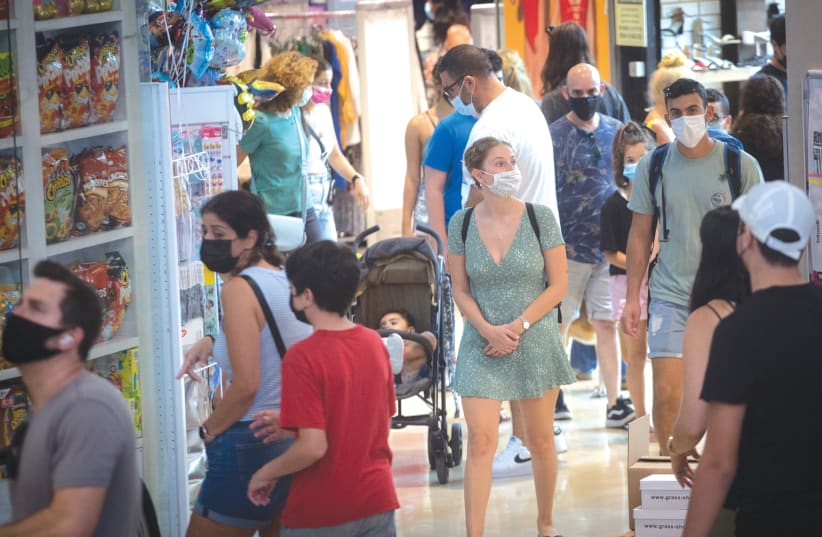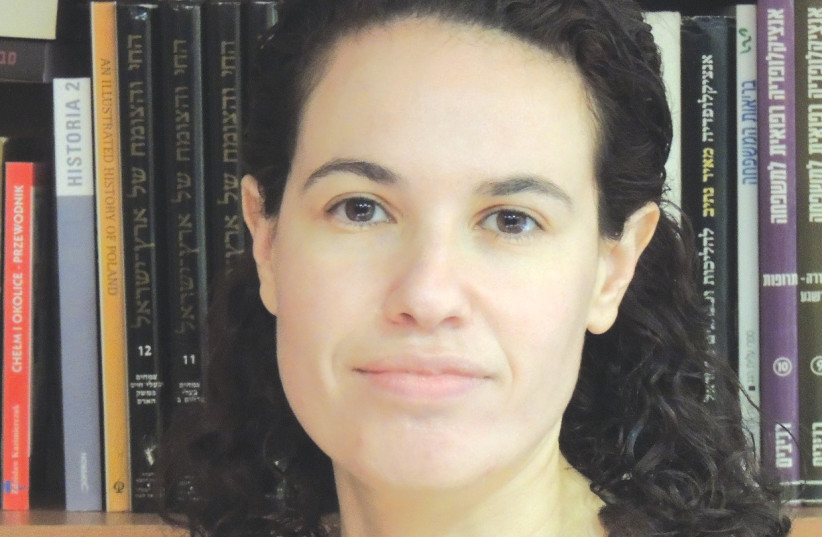COVID-19 has resulted in more than four million people dead and the world’s economy on the brink. The crisis has also left psychological and emotional scars that could have long-lasting and wide-ranging effects.
“It’s not every day that humanity faces a cataclysmic event such as a global pandemic,” said Prof. Alon Chen, a neuroscientist at the Weizmann Institute of Science. “Although the far-reaching health and economic aspects received most of our attention... it was clear from the get-go that the pandemic itself, and the ensuing containment policies that included nationwide lockdowns and social and physical isolation, would have a momentous impact on our overall emotional well-being.”
In many ways, the world is still far from exposing the full emotional and behavioral impact of the crisis, said Asaf Benjamin, a research student in Chen’s lab.
“Studies coming in from all around the world – from China to Australia – have only just begun to reveal the scope of the pandemic’s effect on mental health,” he said.
Benjamin was one of a small team of researchers from the Weizmann Institute that helped develop a questionnaire dedicated to the mental and emotional effects of COVID-19, which they distributed over six weeks, between the end of the first wave in Israel and the beginning of the second – late April to early June 2020.
Nearly 5,000 Israelis answered the digital survey, which used clinically validated instruments to assess anxiety- and depression-related emotional distress, symptoms and coping strategies. It also evaluated how changes in the pandemic’s dynamics affected emotional well-being.
The results, which were recently published in Molecular Psychiatry, showed increased mental distress among most respondents, but that women, young adults and people who became unemployed as a result of the crisis were hardest hit.
Benjamin said that the team was not surprised by the stress levels of women, who tend to consistently report higher levels of anxiety than men in most situations, partially due to hormones and other biological factors.
However, the unemployed population was more concerning.
“From what we found, these people were really susceptible to the stress effect of the pandemic, and I am not sure this population got enough attention from mental health professionals,” said Dr. Yael Kuperman, who also works in Chen’s lab.
She explained that work is not just about financial stability, but can also serve as a social and emotional safety net, which was lost to people who were fired or put on furlough as a result of the crisis.
On the other hand, those who managed to continue participating in social events and who maintained what the study’s authors described as a “normal social life” during the pandemic, were generally less distressed – even if they were supposedly at an increased risk of infection.
“This stresses that we all need a social network, that this is part of the coping mechanism, to have someone to contact and speak with – family, friends or some professional aid,” Kuperman said.
The study also showed that fluctuations in the number of new daily coronavirus cases was reflected in mental distress – the larger the daily count, the greater the mental distress, and vice versa.
Logically, people who were at higher risk for developing severe cases of the virus – immunosuppressed individuals, those with lung, heart or kidney disease, for example – reported more stress. Similarly, people who were forced into isolation or caught the virus reported significantly higher levels of worrying.
In general, the level of distress that the team found was “less severe” than the levels reported during times of war or military operations. But Benjamin said that does not negate that “there is a very significant impact on people’s emotional state, even to the point where people are clinically ill.”
He cautioned that people who “bothered to actually fill out the survey” may be those who did not feel as many threats or feel as anxious, something that the researchers could not account for.
Moreover, although the reported study looked only at a specific six-week window, he said the researchers did capture data past the official assessment period and can see that anxiety levels kept going up as the pandemic dragged on.
ONE SPECIFIC population that was hit hard by the crisis was healthcare professionals (HCPs), who served – and continue to serve – on the frontlines.
In the largest social media study to track emotional changes and discourse during the COVID-19 crisis (recently published in the Journal of Medical Internet Research), a team of researchers from Ben-Gurion University of the Negev said they found significantly decreased joy, increased sadness, fear and disgust among this constituency.
Specifically, the researchers analyzed more than 53,000 HCP tweets from several hundred Twitter accounts. The tweets were in English, mostly from the United States, but also from the United Kingdom, Canada and other English-speaking countries.
They found that there was a sharp increase in online activity among healthcare professionals beginning as early as the first wave, including posts that indicated “increasing sadness and decreasing joy,” said Dr. Rami Puzis, a senior lecturer in BGU’s department of software and information system engineering.
He said it should serve as “a warning to health organizations about the importance of better mental health support to help HCPs cope with emotional pandemic consequences.
“Healthcare professionals, now more than ever, must be granted suitable mental and medical support as they are at the forefront of a worldwide pandemic,” said Doug Seserman, chief executive officer of Americans for Ben-Gurion University.
The study also showed that spikes in infection could almost be predicted by healthcare professionals’ tweets, which expressed greater levels of fear just before a new wave.
“This indicates that many HCPs, beyond those working in epidemiology, observed and were adequately qualified to anticipate pandemic development,” Puzis said. “They understood that it was going to get worse and so they already started to fear.”
Some 44% of the discourse shared by these professionals was centered on the pandemic throughout 2020, the study also showed. Their tweets, said Puzis, were largely focused on combating fake COVID news.
“When you speak to professionals in the field, you can feel” their negative emotions, said Dr. Odeya Cohen, of BGU’s Department of Nursing, who also worked on the report. “In this large-scale study, you see it another way.”
She added that this crisis is unique in that healthcare professionals internationally are facing the same emergency.
“Normally, there are different emergencies according to each location,” she said. “But here, health professionals around the world are feeling the same things. This is one of the reasons we can work with such a broad data set.”
ANOTHER Israeli research team revealed that physiological information collected from individuals long before the onset of COVID-19 could predict mental well-being during the pandemic.
“Your basic physiological activity at rest two or three years ago predicts how you react to COVID today,” said Prof. Ilanit Gordon of Bar-Ilan’s department of psychology and Gonda (Goldschmied) Multidisciplinary Brain Research Center.
She conducted her study, which was published in the journal Psychophysiology, with Prof. Danny Horesh of Bar-Ilan’s department of psychology.
When the crisis hit, professors like Gordon were unable to work with people in their labs. As such, Gordon sought to see if any of the data she had collected over the past several years could be useful in understanding coronavirus.
“When you come into the lab to take part in a study, initially you have to sit and relax for five minutes, and we take your baseline measurements: heart rate, respiration,” Gordon explained. “We wanted to see if those baseline rest measurements could tell you something about how that individual was going to cope” during the pandemic.
The team received responses from 185 Israeli adults who had been in the lab in the past. They assessed their mood regulation since COVID-19 began and their well-being during lockdown in mid-2020.
What they found was that individuals with higher respiratory sinus arrhythmia (RSA) were better able to cope with negative feelings that emerged due to COVID and reported better psychological well-being during lockdown, Gordon said.
RSA shows one’s heart rate fluctuates according to one’s respiration, and Gordon said previous studies have shown that people with lower RSA may be more distressed, while people with higher RSA tend to have better health outcomes and be better emotionally regulated.
On the other hand, people with a high skin conductance level (SCL), which measures activity of sweat glands in the palms, tend to have more trouble coping.
In the case of people with high SCL and high RSA, the SCL tended to be more dominant, meaning that the RSA did not have the expected positive impact, because these individuals were already distressed. That’s likely because people with high SCL tend to be more vigilant during times of distress and more distressed overall, Gordon said.
“This type of data is collected everywhere – in clinics and hospitals,” Gordon explained. “This information can help us determine which individuals may be at risk for heightened mental distress and enable us to better locate and treat them.”•

